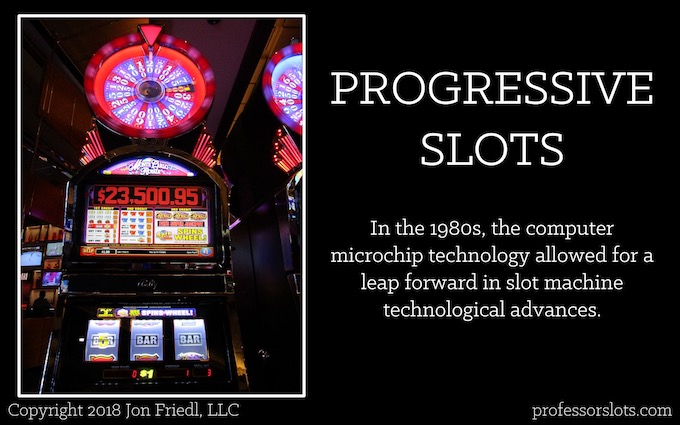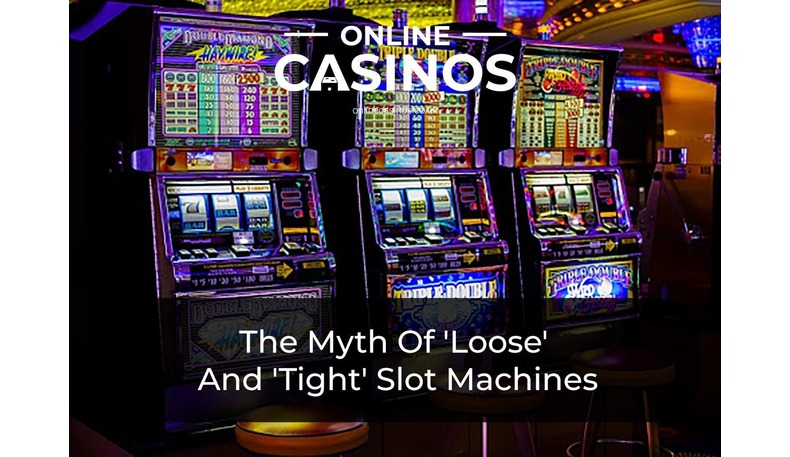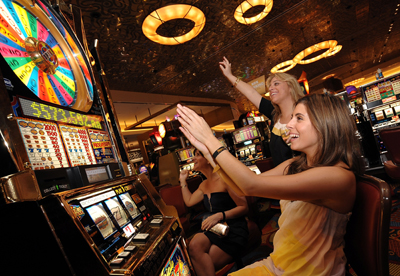Can Casinos Tighten Or Loosen Slot Machines
Slot machine payoffs, known as the takeout, can be adjusted quickly and easily by the casino. Most states simply require the casino to notify the state gaming regulation commission of the change. 66 views View 1 Upvoter. Slot or video poker machines that have higher payback percentages are referred to as “loose” while those with lower returns are “tight.” The slot payout percentages published in Strictly Slots and Casino Player represent the average percent of each slot wager that is returned to the players in jackpots. 10 Secrets Casinos Don't Want You to Know. Subscribe for more amazing videos! Casinos are multi-million dollar business.
- Can Casinos Tighten Or Loosen Slot Machines Near Me
- Can Casinos Tighten Or Loosen Slot Machines For Sale
- Welcome to the #1 Gambling Community with the best minds across the entire gambling spectrum. REGISTER NOW!
- Join our $5,000 Cash Giveaway!
Win Cash by Posting and Inviting New Members! - Have a gambling question?Dismiss Notice
Post it here and our gambling experts will answer it! - Discussions in this section are assumed to be EV- as they are outside of the Advantage Play section. For EV+ discussions, please visit the Advantage Play sub-forum.Dismiss Notice
Discussion in 'Casino Forum' started by Karen Nathan, Apr 1, 2020.
Advertise with us.In the April issue of GGB, “That Winning Feeling” by Dr. Katherine Spilde and Dr. Anthony Lucas was published, and immediately the editors got deluged with responses. That “Winning Feeling” presented research that showed slot players could not tell the difference between loose and tight slots in several controlled experiments.
The article and the responses simply deepened the ongoing debate that often pits operators versus manufacturers. Operators say they must keep their slots rather tight because of the costs of the slot games (buying, leasing or participation), and manufacturers urge looser slots so players can enjoy the bonuses that result from longer game play.
The following responses from two of the most experienced slot experts in the business—Buddy Frank, a longtime slot director for several casinos, including California’s Pechanga Resort & Casino; and Michael Meczka, a former casino marketing executive and longtime marketing consultant—are a good example of the feedback GGB received about the Spilde/Lucas article.
———————————————————
Winning With Loose Slots
By Buddy Frank
The debate about slot odds between “stat nerds” and the “on-the-floor” slot operators has been raging for almost a decade. A good example was in the recent GGB article by Dr. Katherine Spilde and Dr. Anthony Lucas.
Can Casinos Tighten Or Loosen Slot Machines Near Me

Sadly, their argument to tighten slots has been winning across the country, and especially in Las Vegas. I think this is a huge error. The irony for me is that while I’m a 30-year “on-the-floor” guy, I’m also a nerd devotee of good statistics. I just don’t think on this topic we’ve found the right stats to use. Therefore, I’m forced to cite experientials and “grandmother” research to argue my points.
Let’s consider the two individual slot machines described in the Spilde/Lucas article: one at 8.01 percent hold and one at 5.91 percent hold. I’ve learned over the years that performance measurements are seldom pure, in that each factor (actual win, theo win, coin-in and handle pulls) can dramatically affect the other.

Imagine you started playing either machine with $100 and lost it straight away with no wins whatsoever (aka the “Buddy Frank Experience”). The house’s coin-in would be $100; the theo win would be either $5.91 or $8.01. The actual win would be $100.
If I were playing a two-coin $1 game, the handle-pull number would be 50. The very next player arriving with $100, but with normal luck, could enjoy hours of play before losing their initial bankroll and have stats that are wildly different, except for the actual win ($100 in both cases). Coin-in could range from $100 to six figures. And theo win would simply be the PAR times the CI. Handle pulls would also skyrocket. A third player may actually leave ahead.
“….if players cannot detect differences in hold percentages, then casino operators may be able to improve game performance by increasing the theoretical hold.”—Spilde & Lucas, April 2017
Those facts bolster the authors’ suggestion that players could have a good or bad experience with either hold setting, and they probably couldn’t tell a tight machine from a loose one in a limited number of trials. So why not try an extreme? If no one will notice going to 8.01 percent; why not jump it from 5.91 percent up to the Nevada legal limit of 25 percent? And, if it weren’t for regulations, why not try 98 percent or 99 percent?
Given current machines’ greater volatilities and hit frequencies (despite tighter slots), I really don’t think you’d notice any difference (except higher profitability) for a certain amount of time if you went to a 1 percent player payback. You know from player data that some folks win, but most loose. As I mentioned above, maybe one player might still win. So 99 percent wouldn’t be that noticeable in a limited number of trials for most folks. Right?
I’m hopeful that most of you said “no,” and instinctively realize that you’d be closed before the end of the year.
So if you agree, then you’re with me that players can feel a change in odds. But only if it’s big enough and not if it’s small? Or maybe only with time? Those of us in operations who have tightened machines in our careers have noticed that profits do increase right away. But it doesn’t last.
There are some good reasons for this. Citing casino lore: all players have either a “monetary” or a “time” budget, and you can’t change either one. The increase in profits from tighter hold is not because those players on monetary budgets dig deeper. They don’t. They just leave sooner than before. But those on time budgets stay the same amount of time as before, but end up spending more.
In my experience, this “increased profitability” lasts about 180 to 270 days, and then there’s a tailspin. Despite what some analysts believe, our guests aren’t stupid. It takes some time, but players do realize that their money doesn’t last as long or that they are paying a lot more for the same entertainment experience. I’ve never seen a casino survey that doesn’t rank “I feel lucky” as one of the most important attributes for guest satisfaction. Why would you risk that?
“A dollar won is twice as sweet as a dollar earned.”—Paul Newman
Think you could recover quickly once you started to see the numbers decline? You can’t! At least not without a lot of pain and incremental expense. Loosening your tight machines takes even longer to make an impact, and requires massive marketing efforts. In the interim, you’ll get a double whammy of looser slots, but fewer customers as you work to rebuild your former base. Simply put, any decision to tighten machines should be done very, very cautiously. The way back is extremely difficult and expensive.
Again, I acknowledge that the short-term math models are against my simple arguments, but consider some real-world examples. In New York, at the Resort World’s Aqueduct property, the nature of their unique VGM machines gives them one of the loosest hold percentages in the country (4.95 percent in 2015-16). But, I can assure you that anyone, anywhere would kill to have their current revenues. Last year, they did almost $200 million more in slot revenue than all 45 casinos in Reno, Nevada combined.
Resorts World racino at Aqueduct tops in nation in slot machine revenue generating $57.5 million during May—New York Daily News, June 2016
Speaking of Reno, two casinos there have consistently featured some of the country’s loosest odds. Today, the Atlantis and Peppermill properties are booming, while many others in the area (including some large corporate properties) have struggled. It is not a coincidence that most of them have tighter slots. The Peppermill’s numbers are private, but Atlantis trades as Monarch Casinos (MCRI) on NASDAQ. Take a look at their five- and 10-year growth rates in a much tougher market than Las Vegas.
My last example comes from Oklahoma, where VGT’s Class II machines are wildly popular. Everywhere else, these games seldom perform as well as Class III games (where both are allowed). Many say this is because Oklahoma only allowed Class II for years, and so their players developed an affinity for VGT games. While there’s some truth to this, I think an even more important factor is that early VGT machines only offered loose odds. Until somewhat recently, this manufacturer didn’t even make a machine with a hold over 5 percent, even in pennies. Today, many of these loose VGT games outperformed the much tighter Class III games with PARs of 8 percent to 14 percent in pennies.
Finally, in discussions with CEOs of the top slot manufacturers, all expressed private concerns about the trend to tighter slots. Think about that. Their job is to make their casino clients more money, and thereby sell them more machines. If they thought producing games with higher hold percentages was the way to achieve this, they’d be leading the charge. Admittedly, most have succumbed to the demands from many of the larger corporate customers to produce tighter and tighter hold options. But in private, they shake their heads and worry this trend is going to kill the “Golden Goose” of long-term slot profitability.
“….the gambling equipment industry’s largest trade association found slot machine hold percentages have increased a combined 14.5 percent across the nation over the last 10 years while the revenue from the games has grown just 1.1 percent.”—Las Vegas Review Journal, August 2015

So, just because we in the slot world have the ability to temporarily hide our pricing changes from the public doesn’t mean it’s the right thing to do. Even “loose” slots have a strong profit margin compared to almost any other form of retail. And now is an especially critical time to be careful when our guest’s expendable time and dollar budgets are already being attacked by Netflix, streaming music, online games, resort fees, paid parking and grandchildren (that last one may just be me).
You can fool some of the people all of the time, and all of the people some of the time, but you can’t fool all the people all the time.—Abraham Lincoln, 1856 Republican Convention
Buddy Frank is a retired slot operations executive and current consultant with BF Slot Strategies. He can be reached at [email protected].
——————————————————-
Imperfect Experiment
It’s wrong to say slot players don’t notice hold differences.
By Michael Meczka

The article by Dr. Katherine Spilde and Dr. Anthony Lucas in the April issue of GGB makes the claim that slot players cannot tell the difference between varying slot holds. This is misleading. To project the findings of four or fewer test games to a casino’s universe of 1,500-plus games is questionable. Then to imply patrons, across all venues, are insensitive to varying hold rates raises even more serious questions.
/man-and-woman-on-slot-machine-119717081-5afdc0a3ff1b7800203afd7c.jpg)
Granted, infrequent patrons in non-competitive markets may be willing to play high-hold games, as there is no alternative. But frequent patrons in competitive markets are not willing to do so.
While slot pay tables may not be readily visible, the frequent players know from experience which games provide better price/value, allowing longer play time in the casino on their fixed budget. These players are accustomed to, and accepting of, giving the casino their entire budget on the condition the casino reciprocates by allowing them to play longer.
As you know, we are a research group. We are familiar with similar studies. One was a 12-game evaluation with six games set at 9 percent and six games set at 7 percent. All else was equal, including themes, cabinets, location in the casino and pay tables. The result after 120 days was the 7 percent hold games averaged a minimum of 40 percent more coin-in than the 9 percent hold games.
When the frequent patrons in this study were queried why they selected a specific game in the array, the majority simply replied, “I can play longer,” or “It lets me play longer.”
Consider two patrons, each with a $1,000 gaming budget, each playing max coin of $5 per spin at the same game in the same environment. One game has a theoretical of 8 percent and the other a theoretical of 6 percent. Each game was played until the budget was exhausted with no money remaining to cover a $5 wager.
After 2,489 spins, on average, the 8 percent game has exhausted the budget, compared to the 3,321 spins on average required before the 6 percent game exhausts the playing budget. Assuming a spin every 3 seconds, play time would be 2:04 hours for the 8 percent hold game compared to the 3:18 hours for the 6 percent hold game.
The Pareto Principle, which states that 80 percent of revenue will be generated by 20 percent of customers, well applies to frequent patrons in competitive gaming markets.
There is no doubt these more valuable patrons can certainly tell the difference between two and three hours of average play.
Can Casinos Tighten Or Loosen Slot Machines For Sale
In qualitative sessions that we have conducted, these same valuable patrons lament not being able to stay in play for what they consider to be a reasonable time proportionate to their budget.
This Global Gaming Business article would be a great disservice if casino operators adopt a strategy of higher-holding slots based on a four-game study.
The article states, “Further research is necessary and the results cannot be generalized beyond the parameters of this study.” Casino operators are well-advised not to increase hold until further conclusive research, including in-depth probing with avid slot players, is completed.
Michael Meczka is president of Meczka Marketing Research Consulting, and can be reached at 310-383-5947.